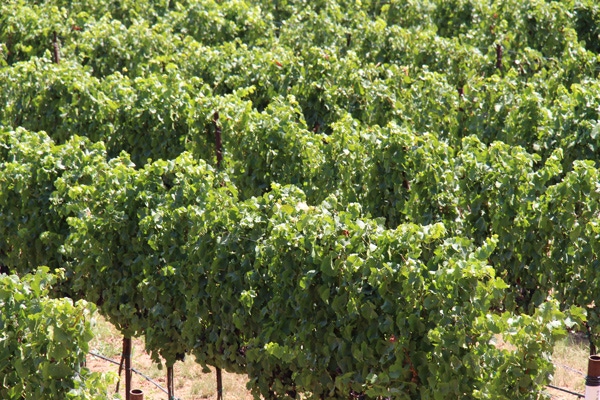
Early-season warning signs of potential trouble in the vineyard
Early-season Botrytis shoot blight may occur following frequent spring rains. Flowers can become infected during bloom. Then the fungus generally becomes dormant until late in the season when sugar concentration increases in the infected berry. The fungus then resumes growth and spreads throughout the berry.

Among signs of possible problems in your vineyard during the period of rapid shoot growth following bud break is flagging or wilting of the shoots, themselves, or the tips. It could indicate the presence of the branch and twig borer, Botrytis, or powdery mildew.
To determine the likely cause, University of California Cooperative Extension IPM specialists recommend examining the shoot closely. If you see wilting of the entire shoot, look for a hole at the base. This could indicate feeding by the branch and twig borer.
However, if flagging is accompanied by a lesion at the node of the shoot, try to break or cut the shoot between the flaccid areas and adjacent areas with normal turgor. Brown discoloration on the cut surface is evidence of Botrytis.
On the other hand, newly emerging shoots displaying malformed foliage, stunting and a white powdery or dusty appearance are symptoms of an overwintering bud infection by powdery mildew.
In the case of the branch twig borer, larvae bore into wood at dead or dying parts of vines, often in old pruning scars. Adults may burrow into fruiting canes at the base of the bud or shoot or into the crotch formed by the shoot and spur. Feeding is often deep enough to completely conceal the adult in the hole. Feeding at the base of shoots on spurs will cause shoots to wilt and fall. This pest is most serious in cane-pruned vineyards where feeding on canes can cause them to break when shoots reach a length of 10 to 12 inches, if a strong wind occurs.
Early-season Botrytis shoot blight may occur following frequent spring rains. Flowers can become infected during bloom. Then the fungus generally becomes dormant until late in the season when sugar concentration increases in the infected berry. The fungus then resumes growth and spreads throughout the berry. Infected berries split and leak, thus allowing the pathogen to grow and sporulate on berry surfaces and spread to adjoining berries by mid-season. Spores from infected fruit can directly infect intact, ripe berries as harvest approaches.
The fungus overwinters as sclerotia in berry mummies lying on the ground or left hanging on the vine and in canes. Germination and spore production occur in spring. Infections require free water for a definite period of time depending on temperature. Infections may occur during bloom should rains occur. Preclose rachis infections often occur on Chardonnay.
The powdery mildew fungus overwinters as dormant mycelium in buds or as chasmothecia (spore structures). On warm winter and spring days when moisture is abundant, chasmothecia burst and release ascospores, which are the primary source of infection.
As spores are produced, the infected areas take on a white, powdery or dusty appearance. Spores are released when 0.1-inch of rain or irrigation is followed by 13 hours of leaf wetness and temperatures are between 50° and 80°F. Seven to 10 days after this initial infection, check for powdery mildew by collecting 10 to 15 basal leaves from 20 or so vines at random.
Examine the under surface for powdery mildew spores. If spores are found, then monitor disease development by using the powdery mildew risk assessment index. The disease remains a threat throughout the season as long as temperatures are moderate (70° to 85°F).
More information on managing these three crop threats is available online at http://www.ipm.ucdavis.edu
About the Author(s)
You May Also Like



